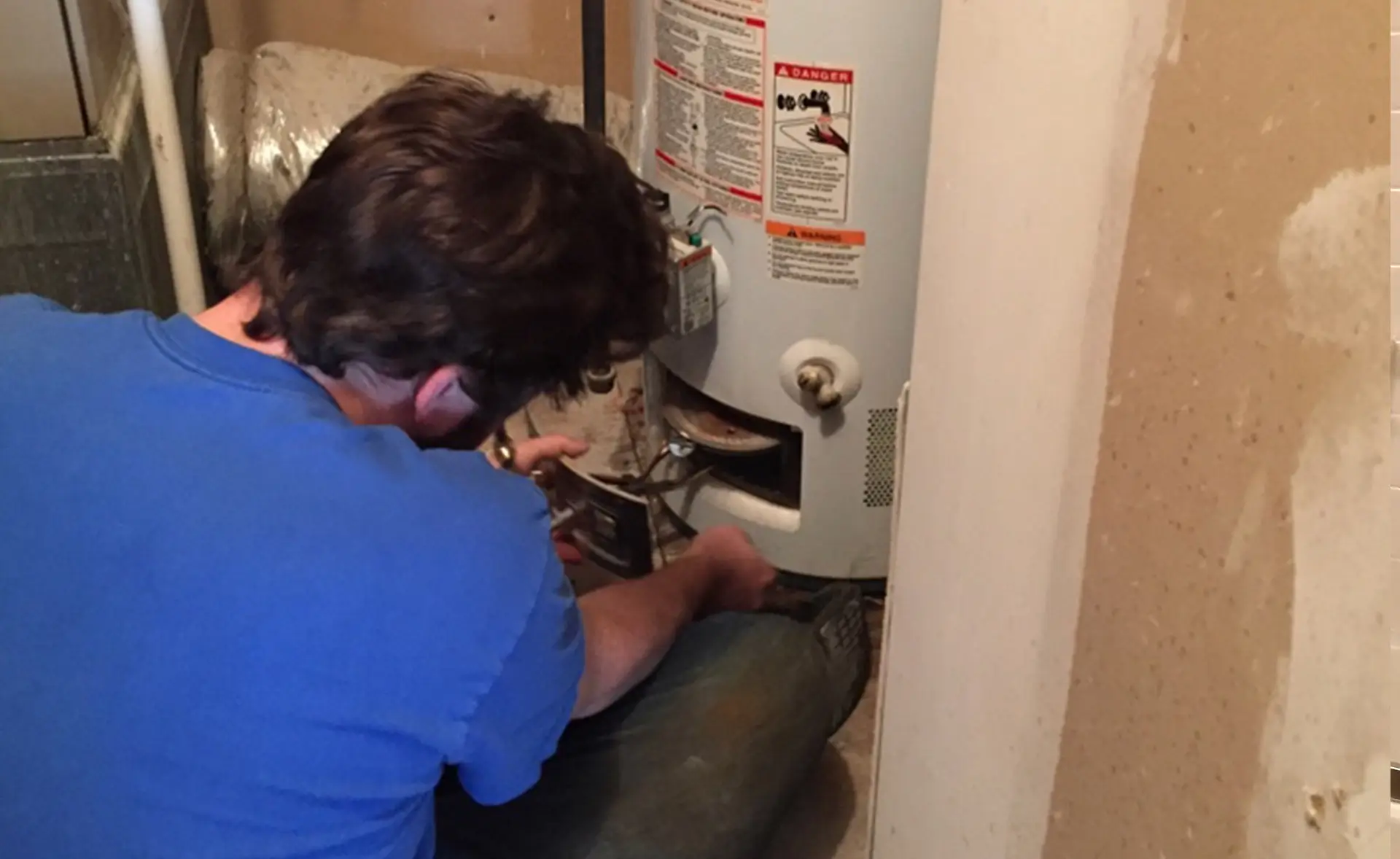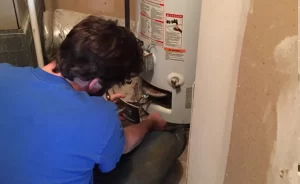Tank Types
There are 2 kinds of traditional water heaters: electric and natural (LP gas). First let’s discuss electric water heaters.
Electric Water Heaters Repairs
Residential electric water heaters typically have two elements, two thermostats, a temperature and pressure relief valve and of course, the tank that stores the hot water.
The most common problem of electric water heaters is not enough hot water. If this is the case, you’ll want to test the elements first. You’ll need a Phillips head screwdriver, a test meter to check ohms and voltage, and an element socket to remove the element from the water heater tank.
Here are the steps to check your electric water heater elements:
-
Turn off the electric power to the water heater.
-
Remove the upper and lower panels that cover the elements and thermostats and remove the plastic snap on covers to get access to the elements and thermostats.
-
Remove the two wires connected to the elements.
-
Turn your test meters to read ohms and touch the two probes to the element, one probe to one screw and the other probe to the other screw. You’re testing the element for continuity. You should get a reading of between 10-16 ohms. If so, the element is good and doesn’t need replacing. If you get no reading on the element, move on to the next step to replace the element.
-
The surest way for a homeowner to do this is to drain the water heater. It’s not necessary to drain the water heater but you can if you don’t feel confident doing it the way I’m about to explain. Just a quick note. This no drain the water heater method will not work if you have any drippy faucets or running toilets. I create an airlock in the water system. To do this, close the valve on the cold water inlet pipe at the top of the water heater. Make sure no one turns on any faucets anywhere in the house. Attach a short hose (we use a 3’ hose) to the drain valve at the bottom of the water heater and put the other end of the hose in a bucket . Open the drain valve to relieve the pressure from the tank. Only a small amount of water should drain out before it stops completely (a gallon or less). Then close the drain valve. Your airlock is created and you’re ready to proceed. If the water doesn’t stop draining, it means your shut off valve at the top of the water heater doesn’t close completely and should be replaced. If you’re still determined to try the no drain method, get a water meter key and turn off the water to the whole house at the street. Then go through the above steps again.
-
Place your element wrench on the element, slide a screwdriver through the holes of the socket and turn counterclockwise to loosen the element. Get your replacement element ready to insert with one hand while you finish removing the element from the water heater with your other hand. You want to do this fast. Pull the old element out and quickly insert the new element and hand tighten. If you do this right, you’ll only spill about a cup of water. Then tighten good and snug with the element wrench and screwdriver.
-
It’s a good idea to go ahead and replace both elements and thermostats since you already have the power off and covers off. You can purchase all parts in a kit that you can pick up at a big box hardware store. Hint: Take a photo of thermostats and elements before you remove the wiring so you won’t get confused when it’s time to reconnect everything. Also, make sure the tank is completely full of water before turning the power back on or you will burn up the elements.
Gas Water Heater Repairs
Follow these steps if your gas water heater is not producing hot water:
-
Check to see if the pilot light is out. If it is, follow the relighting instructions on the water heater. If that doesn’t work, you will need to replace either the thermocouple or the gas control valve or possibly both. There should be a phone number on your water heater or instruction manual to call for troubleshooting help. If your gas water heater is still under warranty, the manufacturer will send you parts for free.
-
Is the Temperature and Pressure Relief valve leaking? All water heaters, gas and electric, have a T&P valve. This may be a symptom of high water pressure on your whole house. You can pick up a pressure gauge at a big box home improvement store that will screw onto an outside hose bib. If your water pressure is over 75 psi, you’ll need to replace the Pressure Reducing Valve (PRV). This is most likely located where your water line enters your house. Don’t buy a cheap PRV or you’ll be replacing it sooner than later. If your water pressure is less than 75 psi, you won’t need a new PRV and proceed to step 3 below.
-
Once that task has been completed, you’ll need to check the T&P valve at your water heater to make sure it reset itself. If it’s old, it may not reset and you’ll have to replace that too. Shut off the water to the tank and drain about 10 gallons of water from the tank. You’ll have to cut the pipe on the outlet side of the T&P valve. Then get a big slip joint pliers and turn the T&P valve counterclockwise to remove it. Install the new T&P valve and reconnect the pipe you had to cut.
-
While you’re at it, go ahead and replace the expansion tank too since the high pressure probably damaged it too.
Can I fix a leaking water heater?
If your water heater is leaking, that’s something that cannot be repaired. You’ll need to replace it. All water heaters, gas, electric and tankless, eventually succumb to old age and start leaking. All water heaters have a life expectancy of 10-20 years.
How to Replace an Anode Rod:
All tank type water heaters have an anode rod inside the tank. The anode rod protects the inside of the tank from the corrosive effects of water. It’s made to last approximately 6 years. That’s why a standard tank type water heater comes with a 6 year warranty. Water heaters with longer warranties have two anode rods which will add several more years of protection. It is possible to replace an anode rod, but it is usually quite difficult and you’ll need an 1 ⅛ socket, a really big socket wrench and most likely a cheater bar to go over the socket wrench in order to get enough torque to loosen the anode rod and remove it from the top of the tank. There’s usually a lot of things in the way that make this even more difficult. You’ll also need a type of counter leverage to keep from rotating the water heater while trying to replace an anode rod.
Things That Can Go Wrong with Water Heater Repairs:
-
The water heater shut off valve at the top of the water heater won’t shut the water off. This is a malady of gate valves. You’ll have to replace the shut off valve. Replace it with a ball valve.
-
Most homeowners who attempt these repairs do so after work or on the weekend. Just know that if you get in over your head and need a plumber after hours or on the weekend, you’ll be paying overtime rates.
Schedule a Plumber
Schedule a plumber if you need assistance, we are happy to help.
Read our reviews to learn more about us or our services.

